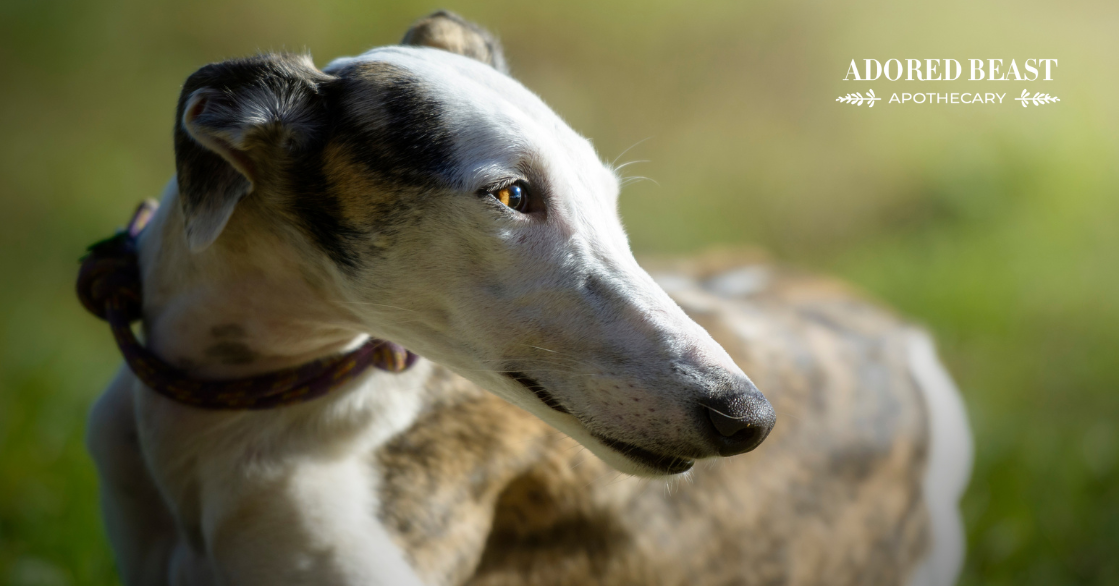Dog ear infections: so many pet parents have been there. Ear infections are very common in dogs. In fact, they’re ranked as the third most common medical condition our dogs face. I saw them all the time in my clinic.
Sometimes they’re a symptom of a larger health issue, and sometimes they’re a result of something unavoidable.
But whatever the cause, it’s important to get them under control. They’re painful, can cause your dog significant discomfort, and they can just get worse and worse if left to resolve on their own (which 99.9% of the time, won’t happen).
And these ear infections are not picky. Young or old dogs, floppy-eared dogs or dogs with ears that reach to the sky, little chihuahuas or massive Great Danes: all dogs, breeds, ages, etc. can get ear infections. Sure, some breeds might be more prone to them because of the structure of their ears, but really no dog is immune. This information is important for all dog parents!
Since so many pups are troubled by ear infections, I thought it was time to talk about the many ways we can help them. In my experience, being proactive and knowing the causes and the best tips for prevention can work wonders for those ears, but of course knowing how to approach them when they spring up is crucial too!
Types of Dog Ear Infections
There are three types of ear infections:
- Otitis externa – this is the most common ear infection for dogs. It consists of inflammation affecting the outer portion of the ear canal.
- Otitis media – inflammation of the middle ear.
- Otitis interna – inflammation of the inner ear.
Both media and interna are less common that otitis externa, and they’re typically caused by the spread of infection from the external ear (otitis external). Sometimes though, they’re just a result of the inflammation. When the opening to the ear canal becomes inflamed, the opening to the ear canal becomes narrow, making conditions ideal for further infection and yeast inside the ear. Otitis media and interna can be very serious and may result in deafness, facial paralysis, and vestibular signs. I really recommend working with your trusted veterinarian and holistic practitioner to manage symptoms and clear up the infection.
So, what might cause an ear infection to develop?
Causes of Dog Ear Infections
A number of different things can lead to dog ear infections.
- Allergies. Allergies are a major cause of dog ear infections. In fact, ear infections are often a secondary symptom of underlying allergies, especially allergies to dust mites, molds, pollens, and certain foods. These are usually recurring.
- Inflammation caused by allergies. This creates narrowing of the ear canal and sets up the prime conditions for the perfect storm.
- Moisture. Excess moisture in the ear creates the perfect environment for bacteria and yeast to grow. That’s why so many dogs wind up with ear infections after a day at the beach (or dogs with allergies).
- Diet. This is particularly true in cases of yeast infections in the ear. Yeast is naturally present in the ear, but things like kibble can encourage the yeast to overgrow. This is because kibble is full of carbohydrates, and carbs create sugars that feed yeast.
- Medications. Medications, particularly antibiotics and anti-yeast meds, destroy the good bacteria in the gut, leading to long-term chronic disease, including recurring ear infections. Internal ear medications do the same to the skin microbiome, leaving it vulnerable to chronic yeast and bacteria.
- Injuries or Foreign Bodies. Anything that happens to the ear, or gets in there that shouldn’t be in there, can cause an infection to develop.
- Over cleaning or plucking the hair out of the ears. Over-cleaning you’re adding excess moisture that shouldn’t be there (and we now know why moisture is an issue). Plucking ears is a controversial subject but in my experience causes inflammation in the ears which narrows the ear canal and sets up this perfect storm.
Signs and Symptoms
Sometimes, your pup will show very few signs – or even no visible signs at all – of an ear infection. Sometimes the only clue you’ll get that something’s going on is a buildup of gunk, an odour, or some discharge.
Other dogs, however, will let you know. These are common signs:
- head shaking
- scratching their ears
- redness or swelling
- rubbing their head/ear on the ground or furniture
- pain
- scabbing in the earflaps
If you notice any of these symptoms, it’s a good idea to speak with your veterinarian/holistic practitioner and address the ear infection head on.
At the First Sign of an Infection
First of all, never, ever stick anything in your pet’s ear! A q-tip can wreak havoc in a second, and even going too deep with a cloth can have negative consequences.
Also, never put any medications or cleaners in your pet’s ear until your veterinarian is sure their eardrum is intact (they don’t have a ruptured eardrum). If the eardrum is ruptured, and you don’t know, adding the wrong medication or ointment to a ruptured eardrum can cause a much more severe issue. Always have it checked!
When you’re at the clinic, make sure a culture and sensitivity is done. This is really important. You need to see if it is yeast, bacterial, or both (which is often the case). If, for some reason, you have to do antibiotics, you’ll know what antibiotic the bacteria is sensitive to and you won’t be using anti-yeast medications if they’re not necessary.
One of the biggest issues in human and animal medicine are bacteria that are antibiotic resistant. Using antibiotics without doing a culture and sensitive, we’re playing with fire as so many dogs wind up in the situation where antibiotics stop working. This is why I believe it is so, so important to do those tests prior to medication.
I have seen way too many antibiotic resistant infections in animals because of routine prescriptions!
Remedies for Dog Ear Infections
My choice remedies for ear infections are:
- Aconite and arnica 200C or 1M at the initial onset for pain and inflammation. Give every hour, 3 times, and then every 6 hours, two times.
- If it is very painful, red, and swollen, you can add belladonna 200C to the aconite and arnica schedule above.
You can do these before you even get to the vet. You don’t have to worry about whether it’s yeast or bacteria, or if the eardrum is intact, you just start giving them right away.
Once you see the vet, continue with the arnica 200C, and add in:
- Silica 200C and hepar sulph 200C, 3 times a day for 5 days.
The next thing I’m a big, big fan of – something I used at my practice all the time – is called Zymox Otic Enzymatic Solution.
I wouldn’t suggest the one with hydrocortisone, or even the cleaner. Just stick with the simple enzyme solution and follow the directions. It’s the best ear solution I’ve ever used. You can find it on Dr. Judy Morgan’s website right here.
Another option I like is CBD oil. DON’T put it directly in the ear, just put a few drops in the palm of your hand, and using your fingertip gently rub a teeny tiny amount around the outside of the ear. You don’t want it to drip into the ear, just to get around the outside. I’ve found it can really help with the inflammation.
If yeast is the issue, we really recommend treating the yeast, gently, but thoroughly. Our Yeasty Beast Protocol addresses the yeast at the root, naturally, without the harmful yeast die-off. It’s a safe and effective program of gentle herbs and homeopathic remedies.
Preventing Dog Ear Infections
In addition to treating an ear infection, there are also many things that you can do help prevent them in the first place.
- Excess moisture is a common cause of ear infections, so be sure to thoroughly dry your dog’s ears after swimming and bathing. Use a soft cloth and don’t go in deep.
- Don’t clean ears too often.
- A balanced whole food diet will help provide the best nutrition and not feed the yeast, if yeast is in fact the issue. As mentioned, stay away from carbs – that includes starchy carbs like potatoes.
- Add probiotics to help encourage the growth of friendly gut bacteria. A healthy microbiome naturally sets your animal up to be better prepared to fight unfriendly bacteria.
- Consider digestive enzymes to be sure the nutrition that you’re feeding is being absorbed.
- Omega-3s can help address inflammation. Please make sure that they don’t harm the ocean or contain heavy metals!
- Be sure to check for foxtails, pieces of grass, really any debris that could be in your dog’s ear after playing in tall grass.
Dog ear infections can be painful and cause significant discomfort to your animal. And they won’t just go away on their own. Often the ears can tell us a great deal about overall health, and if you dog is showing signs of an infection, it’s always smart to examine their health to discover any undying causes and address them. Treating without knowing is often just suppressing the initial issue, which can just pop back up once medication is completed. The most effective way to say goodbye to ear infections for good is to determine exactly what’s causing them and address it at the root.












